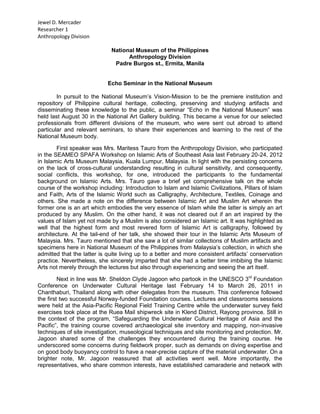
Echo in national museum seminar report
- 1. Jewel D. Mercader Researcher 1 Anthropology Division National Museum of the Philippines Anthropology Division Padre Burgos st., Ermita, Manila Echo Seminar in the National Museum In pursuit to the National Museum‟s Vision-Mission to be the premiere institution and repository of Philippine cultural heritage, collecting, preserving and studying artifacts and disseminating these knowledge to the public, a seminar “Echo in the National Museum” was held last August 30 in the National Art Gallery building. This became a venue for our selected professionals from different divisions of the museum, who were sent out abroad to attend particular and relevant seminars, to share their experiences and learning to the rest of the National Museum body. First speaker was Mrs. Maritess Tauro from the Anthropology Division, who participated in the SEAMEO SPAFA Workshop on Islamic Arts of Southeast Asia last February 20-24, 2012 in Islamic Arts Museum Malaysia, Kuala Lumpur, Malaysia. In light with the persisting concerns on the lack of cross-cultural understanding resulting in cultural sensitivity, and consequently, social conflicts, this workshop, for one, introduced the participants to the fundamental background on Islamic Arts. Mrs. Tauro gave a brief yet comprehensive talk on the whole course of the workshop including: Introduction to Islam and Islamic Civilizations, Pillars of Islam and Faith, Arts of the Islamic World such as Calligraphy, Architecture, Textiles, Coinage and others. She made a note on the difference between Islamic Art and Muslim Art wherein the former one is an art which embodies the very essence of Islam while the latter is simply an art produced by any Muslim. On the other hand, it was not cleared out if an art inspired by the values of Islam yet not made by a Muslim is also considered an Islamic art. It was highlighted as well that the highest form and most revered form of Islamic Art is calligraphy, followed by architecture. At the tail-end of her talk, she showed their tour in the Islamic Arts Museum of Malaysia. Mrs. Tauro mentioned that she saw a lot of similar collections of Muslim artifacts and specimens here in National Museum of the Philippines from Malaysia‟s collection, in which she admitted that the latter is quite living up to a better and more consistent artifacts‟ conservation practice. Nevertheless, she sincerely imparted that she had a better time imbibing the Islamic Arts not merely through the lectures but also through experiencing and seeing the art itself. Next in line was Mr. Sheldon Clyde Jagoon who partook in the UNESCO 3rd Foundation Conference on Underwater Cultural Heritage last February 14 to March 26, 2011 in Chanthaburi, Thailand along with other delegates from the museum. This conference followed the first two successful Norway-funded Foundation courses. Lectures and classrooms sessions were held at the Asia-Pacific Regional Field Training Centre while the underwater survey field exercises took place at the Ruea Mail shipwreck site in Klend District, Rayong province. Still in the context of the program, “Safeguarding the Underwater Cultural Heritage of Asia and the Pacific”, the training course covered archaeological site inventory and mapping, non-invasive techniques of site investigation, museological techniques and site monitoring and protection. Mr. Jagoon shared some of the challenges they encountered during the training course. He underscored some concerns during fieldwork proper, such as demands on diving expertise and on good body buoyancy control to have a near-precise capture of the material underwater. On a brighter note, Mr. Jagoon reassured that all activities went well. More importantly, the representatives, who share common interests, have established camaraderie and network with
- 2. Jewel D. Mercader Researcher 1 Anthropology Division one another, looking forward to another yet to be successful convergence of interested professionals in the field. Last to take the floor was Ms. Marie Grace Pamela Faylona from Archaeology Division. She attended the most recent Developing International Geoarchaeology (DIG) conference held at the University of Tennessee in Knoxville, USA from September 20 to 24, 2011. DIG caters international conferences dwelling on the interdisciplinary field of geoarchaeology. This event brings together a crowd of researchers, practitioners and scholars from around the world to share and discuss endeavors in geoarchaeology through paper presentations, field trips and the like. Usual topics presented in the conference includes land use practice, trade and exchange with geosciences and environmental based topics, human-environmental interactions, landscape reconstruction and site formation processes. Ms. Faylona mentioned that from September 20-22, they had a field trip based workshop to explore the geomorphology and archaeology of the Tennesse River Valley and the last days of the conference were spent for the general session and discussions. Our Archaeologist herself definitely made a job well done that she was able to present her paper on the preservation of giant clam from the Balobok Rockshelter archaeological site. During the question and answer portion, Ms. Faylona was asked if it would be better in conferences as such to proceed first with the fieldwork then be followed by discussions and lectures, as what was practiced in the event, as opposed to the conventional way. She said it works either way but particularly for this case, she happily reasoned out that this „set-up‟ helped in building friendship and in getting to know the participants easily. Obviously the National Museum continues to live up to its duties and core values. Successful efforts of the institution clearly manifest on the achievements of the above mentioned speakers. They continue to inspire the rest of the museum‟s researchers and scholars. This is what we do in National Museum, we do not just educate and stand as a premiere institution for cultural heritage, but we also contribute in taking pride of Filipinos‟ genius acknowledged internationally.
